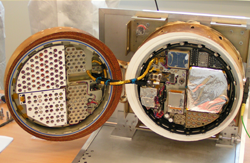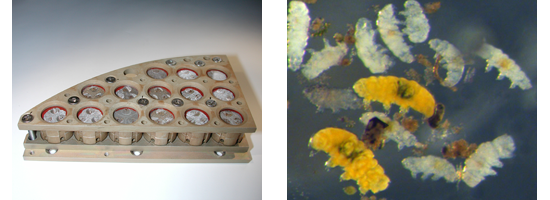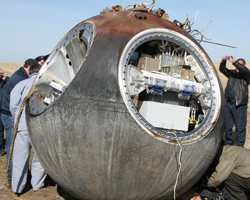Tardigrades in Space
In 2007, a rocket ship was launched from the country of Kazakhstan. Its mission was to see how life was affected by space travel. As it reached an area just outside of Earth’s protection, a little round box on the side of the ship opened its lid. The harsh emptiness of space surrounded the life inside this box. At that moment, tardigrades became the first animal to touch open space, and live.

Before that launch, animals had only survived space in the safety of a spaceship or space suit. Space is a terrible place for Earth’s lifeforms. There’s no air to breathe, no food to eat, it’s freezing cold, and incredibly dry. High-energy light beams from the sun and fast-travelling particles smaller than an atom zip around. These can shoot through living bodies and destroy their molecules.
But tardigrades are really tough. Scientists are not quite sure why, but they can protect themselves from most molecular damage, and fix it quickly too. On top of that, tardigrades can dry up to the point where the emptiness of space doesn’t affect them. They fall into such a deep sleep that they don’t need to eat or breathe.
Preparing Tardigrades for Space
A group of scientists from Sweden and Germany worked together to send tardigrades into space. They picked four different species, to see if some were tougher than others. The tardigrades were dried out and then packed into little metal chambers. All would face outer space and its damaging sub-atomic particles. But, some were in chambers with sun shades that blocked radiation from the sun.

Scientists placed the chambers in a experimental facility about the size and shape of a large birthday cake. Then, they attached it to the space ship. The ship had no humans on it (just experiments) but humans watched it from earth. When the ship was outside the earth’s atmosphere the facility opened for 10 days, bathing the sleeping tardigrades in open space. It closed before the space ship came back to earth again.

Can Tardigrades Live in Space?
Upon landing back on earth, scientists rescued the sleeping tardigrades from the space capsule and brought them back to the lab. There, the scientists could see who survived, and if the survivors were forever changed by space travel.
The tardigrades protected from the sun survived as well as if they had stayed on earth. They went on to make healthy tardigrade babies that didn’t show any effects of their space mission. But, radiation from the sun was too much for most tardigrades to handle. Some of the tardigrades under partial sun shades survived, but all the ones exposed to the full rays of the sun eventually died.
Scientists saw that tardigrades could survive space, but only if they were protected from the sun. However, tardigrades could not live in space. Tardigrades need water to live, grow, and make new tardigrades. There is no water in space, so tardigrades couldn’t live there.

Tardigrade and TARDIS harware images were kindly provided by one of the scientists on the mission, K. Ingemar Jönsson. Space image via Flicker by John Smith. Additional images via Wikimedia Commons. Images from European Space Agency do not apply to the Share Alike license, so they cannot be re-distributed.
Read more about: Itty Bitty Beasts
Bibliographic details:
- Article: Tardigrades in Space
- Author(s): Dr. Biology
- Publisher: Arizona State University School of Life Sciences Ask A Biologist
- Site name: ASU - Ask A Biologist
- Date published:
- Date accessed:
- Link: https://askabiologist.asu.edu/space-tardigrades
APA Style
Dr. Biology. (). Tardigrades in Space. ASU - Ask A Biologist. Retrieved from https://askabiologist.asu.edu/space-tardigrades
Chicago Manual of Style
Dr. Biology. "Tardigrades in Space". ASU - Ask A Biologist. . https://askabiologist.asu.edu/space-tardigrades
Dr. Biology. "Tardigrades in Space". ASU - Ask A Biologist. . ASU - Ask A Biologist, Web. https://askabiologist.asu.edu/space-tardigrades
MLA 2017 Style

Could tardigrades live in space?
Be Part of
Ask A Biologist
By volunteering, or simply sending us feedback on the site. Scientists, teachers, writers, illustrators, and translators are all important to the program. If you are interested in helping with the website we have a Volunteers page to get the process started.

